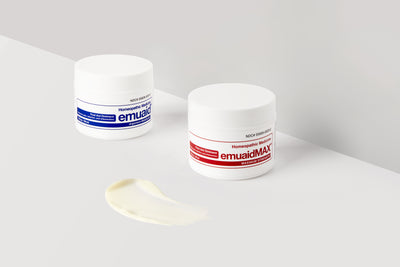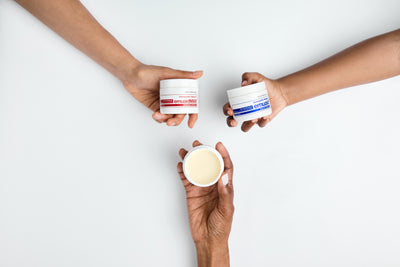Cellulitis - Causes, Symptoms, and Treatment
Table of Contents
What is Cellulitis?
Cellulitis is a painful skin condition that occurs as a result of a bacterial infection within the skin that causes redness and tenderness in the affected area, which may be accompanied by various other symptoms. It can appear in just about any area of the body.
Given that it produces redness on the skin, like dermatitis, it is sometimes also confused with the latter skin condition.
However, cellulitis differs from dermatitis in that dermatitis occurs as a rash caused by skin contact with an irritant, such as poison ivy or certain product ingredients. It can also be caused by eczema, usually accompanied by itchiness, whereas cellulitis is not. But eczema can cause cellulitis.
Dermatitis is also usually contained in the area of the skin that came into contact with the irritant, making it more pronounced compared to the rest of the skin. On the other hand, the infected skin from cellulitis has no lines of demarcation, so it is less noticeable compared to the rest of the skin.
Neither skin condition is contagious; however, cellulitis may also cause sickness; while dermatitis does not.
Cellulitis can sometimes be confused with another bacterial skin infection called Erysipelas; however, this skin condition is usually confined to the legs. Unlike cellulitis, the red, swollen rash it produces has more of a protruding outline, so it stands out from the rest of the skin.
Because cellulitis shares common symptoms with other skin conditions, it is important to have your particular condition properly diagnosed by a licensed physician to ensure safe and proper treatment.
Causes of Cellulitis
The cause of cellulitis is a skin lesion that allows bacteria to enter the inner layer of the skin, causing infection. This is characterized by various visible symptoms on the outer layer of the skin.
Staphylococcus, more specifically, group A ß hemolytic streptococcus and streptococcus pneumonia, and staphylococcus bacteria are the most common culprits of infection in cellulitis; however, the disease can also be caused by other types of bacteria (1).
Streptococcus and staphylococcus bacteria usually are present on the surface of the skin and in the mucous membranes of the nose and mouth, where they pose no threat. However, when a break or opening in the skin occurs, it allows the bacteria to enter, where they will then grow and eventually cause infection.
Some common entry points for bacteria to permeate the skin include:
- Cuts, gashes, and tears
- Puncture wounds
- Surgical wounds
- Fractures, burns, including sun burns, and scrapes
- Ulcers of the skin
- Bug bites and other bites
- Eczema, psoriasis, athletes foot, and shingles
- Chicken pox
- Flaky or dry skin
- Swollen skin
- Bone infections
Certain diseases also make you more prone to developing cellulitis, including diabetes, because it is known to cause sores on the feet and legs, which can result in infection.
Those with a weakened immune system are also at greater risk of developing infections, such as cellulitis.
Cellulitis can also occur on normal skin; however, it is fairly uncommon (2).
Symptoms of Cellulitis
Cellulitis often begins on the lower legs or feet; however, it can also spread to other areas of the body, including the arms, eyes, mouth, stomach, breast, and anus.
Some common symptoms in the affected area include:
- A small patch of redness that tends to spread
- Inflammation or swelling
- The area is tender to the touch
- Pain
- Warmness
- Bruising
- Blisters
- A skin sore or rash that spreads
- A painful bump filled with pus
As cellulitis worsens, it can also cause more serious symptoms, such as:
- A large area of redness and pain
- Abnormally high body temperature
- Feeling cold for no apparent reason
- Nausea and weakness
- A faint or woozy feeling
- Tiredness
- Muscle pain
- Sweating
If your cellulitis symptoms have become more serious, it is essential to seek immediate care because the infection can quickly spread to the bloodstream and other parts of the body, where it can be fatal (3).
How to Treat Cellulitis?
Since cellulitis is a fast-spreading infection, it can quickly affect the rest of the body, causing severe complications. Therefore, it is vital to seek treatment immediately should cellulitis be suspected.
Treatment for cellulitis requires antibiotics to destroy the rapid-spreading bacteria to prevent its growth. However, your doctor may also prescribe pain medication, which some people may feel uncomfortable with. These people may consider more natural remedies for relief.
One natural way to ease the symptoms of cellulitis is to keep the injury clean by washing it with soap and water, keeping a close eye on the affected area over the next few days to ensure it is healing.
You can also soak a clean cloth in cold water and apply it to the infected area to relieve any pain and inflammation. If the infection is in the arm or the leg, keeping the arm or leg raised higher than heart level will also help alleviate discomfort.
A first-aid ointment, such as EMUAID® First Aid Ointment or EMUAIDMAX® First Aid Ointment, may also be applied to help soothe the area.
Your doctor may also recommend keeping the infected area covered with a bandage to help prevent further irritation to the skin and speed healing.
Research shows that once a person has developed cellulitis, they are at a higher risk of developing the infection again, and in the same area, which can eventually damage the lymphatic system and cause chronic inflammation in the legs or arms (4).
Therefore, if you encounter a wound or break in the skin, especially if you have previously suffered from cellulitis, it is essential to care for it right away to prevent it from becoming infected.
Some ways to do this include washing your wound or injury with soap and water and to bandage it right away. It is also vital to clean the area every day to help wash away bacteria that can enter the skin and result in cellulitis.
In the meantime, keep an eye out for signs of infection, such as widespread redness, pain, and pus-filled abscesses.
You can also help stave off cellulitis by taking care to prevent breaks in the skin. One way to do this is by keeping your skin moisturized, preventing cracking that can allow bacteria to permeate the opening.
Keeping your nail tips clipped and even helps prevent cellulitis because it prevents you from accidentally scratching yourself, causing breaks in the skin. Immediately treating other skin infections, such as athlete's foot, and conscientiously managing medical conditions, such as diabetes and eczema, also help lower your risk of cellulitis.
Should your cellulitis reoccur, your doctor may recommend more aggressive forms of treatment, which may include a daily low-dose of antibiotics, or in some cases, even surgery, to release pus from an abscess that has formed in the tissue.
The Takeaway
With a doctor's supervision and proper home care, including cleaning and disinfecting the affected area with an antibiotic ointment, cellulitis can be cleared within just 7 to 10 days following oral antibiotics.
However, in more severe cases where hospitalization is required to treat the infection, an IV antibiotic is often administered until the cellulitis is no longer a threat. Patients are then usually given an oral antibiotic to take at home, which fully clears the condition within about 2 to 3 days.
Whatever the case, hopefully, this short guide has helped you understand what cellulitis is and how to recognize its symptoms, so you can take prompt action to prevent it from spreading and becoming more severe in the event you develop it.
However, the best way to safeguard against cellulitis is to prevent it from occurring in the first place by practicing proper skin and wound care to help prevent any infection.
References
(1). Day, Nick and Torok, Estee. (2005). Staphylococcus and staphylococcus infections.
Medicine. 33(5), 97-100. Abstract retrieved September 10, 2020, from Science Direct database.
(2). Bronze, Stuart Micheal, M.D, Herchline, Thomas E., M.D., and more. (2019, June 14).
Cellulitis. Retrieved September 9, 2020, from https://emedicine.medscape.com/article/214222-overview
(3). S. M. Ellis Simonsen, E. R. Van Orman, B. E. Hatch, S. S. Jones, L. H. Gren, K. T. Hegmann, and J. L. Lyon. (2006). Cellulitis incidence in a defined population.Epidemiology & Infection. 134(2), 293-299. Retrieved September 9, 2020, from US National Library of Medicine National Institutes of Health database.
(4). American Academy of Dermatology Association. (n.d.).Cellulitis: How To Prevent It From Reoccurring. Retrieved September 9, 2020, from https://www.aad.org/public/diseases/a-z/cellulitis-self-care#
Can EMUAID® Relieve Symptoms of Cellulitis?
Yes, our versatile EMUAID® ointment used for shingles can also relieve symptoms of Cellulitis. Our EMUAID® ointment contains antibacterial, antimicrobial, antifungal, and antiviral agents that make it a natural and effective way to relieve Cellulitis symptoms without harsh chemicals or antibiotics that may have adverse effects on you.
Can EMUAID® Relieve Eczema?
Yes, EMUAID®'s unique formula has been proven to provide fast eczema relief. By using EMUAID® for eczema, you can be guaranteed that the product will penetrate deep into your skin. It has a unique delivery system that helps carry powerful healing ingredients so that they can quickly reach the troubled areas of your skin. The unique formulation of this product has been proven to provide relief from your symptoms in as little as 24 hours, and it can help to soothe and heal the skin in just a matter of days.
*DISCLAIMER: The statements on this website have not been evaluated by the Food and Drug Administration. The products found within are not intended to diagnose, treat, cure or prevent diseases. Nothing on this website is intended to diagnose, treat or cure any physical or medical conditions. Results may vary.
Homeopathic claims are not backed by scientific evidence – they are based only on theories of homeopathy from the 1700s that are not accepted by most modern medical experts.
Testimonials appearing on this site are received via electronic feedback through verified customers. They are individual experiences, reflecting real life experiences of those who have used our products in some way or other. However, they are individual results and results do vary. We do not claim that they are typical results that consumers will generally achieve. The testimonials are not necessarily representative of all of those who will use our products.
The testimonials displayed are given verbatim directly from verified customers and are not edited or censored in any way.
SPEER Laboratories. is not responsible for any of the opinions or comments posted to our site. It is not a forum for testimonials, however provides testimonials as a means for customers to share their experiences with one another. To prevent against abuse, all testimonials appear after they have been reviewed by management of SPEER Laboratories. SPEER Laboratories. does not share the opinions, views or commentary of any testimonials on this site, and are strictly the views of the reviewer.



